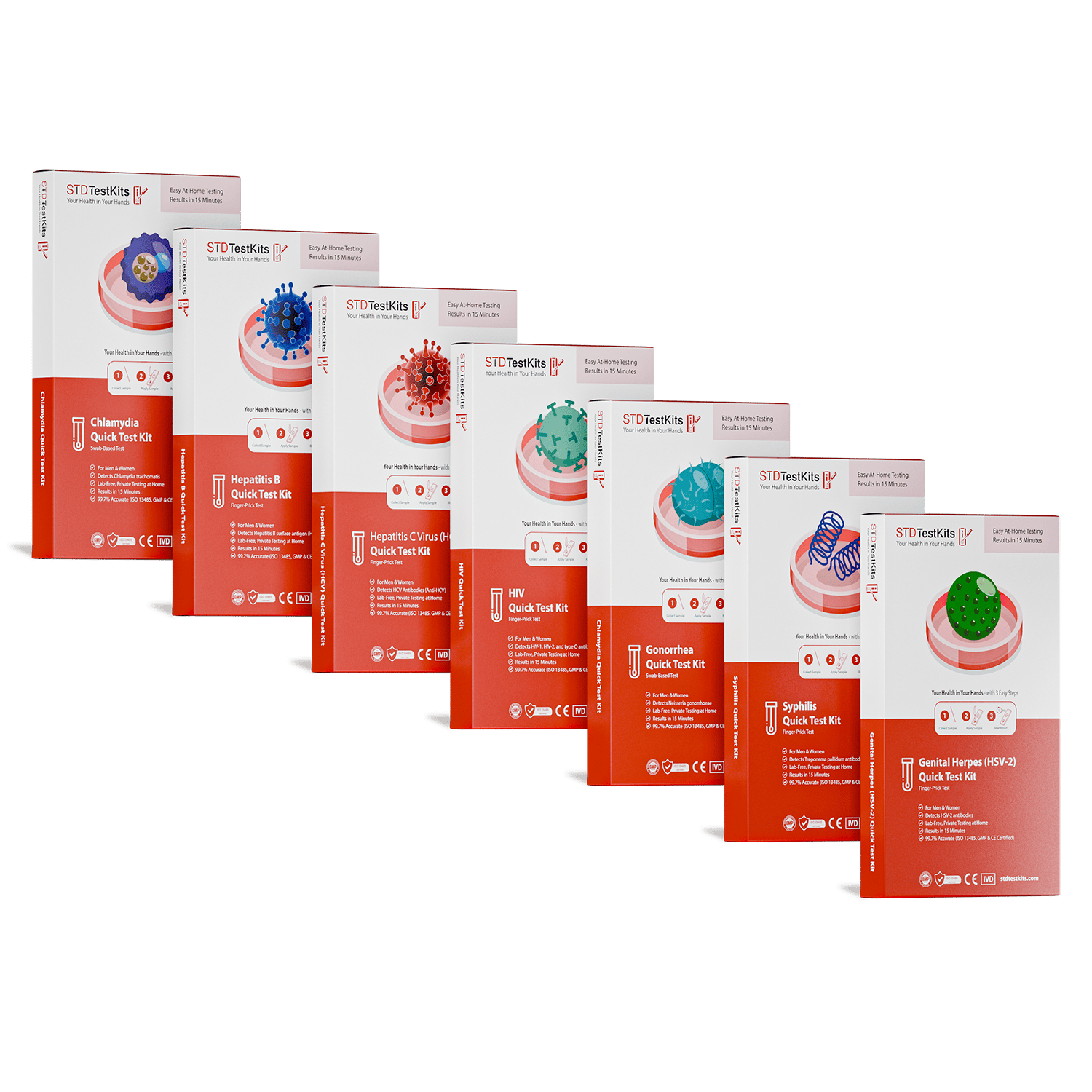No Symptoms, No Problem? Why You Still Might Need an STD Test
Quick Answer: Saliva, blood, breast milk, rectal secretions, and pre-cum can all transmit STDs under certain conditions. Sweat and tears do not transmit STDs. Risk depends on fluid type, exposure, and the specific infection involved.
When the Fluids Get Blurry: Why This Article Matters
Most sexual health education sticks to the basics: vaginal fluids and semen transmit STDs. The rest? Barely mentioned. But that leaves a huge gap for people whose sex lives include oral, anal, non-penetrative, or queer intimacy. Or people who shared a toothbrush. Or got blood on a cut. Or breastfed. Or kissed someone with a cold sore. These situations are real, and they’re often left out of the conversation entirely.
Consider David, who had a small cut on his gums after flossing. He kissed a new partner later that night. Two weeks later, he developed a sore in his mouth and panicked. “Was that enough to catch something?” he asked himself while Googling in bed, afraid to tell anyone. This isn’t hypothetical, it’s lived experience. And too often, shame and misinformation delay testing or keep people in needless fear.
So here’s what we’re going to do. We’ll walk fluid by fluid. We’ll show you what carries real risk, what doesn’t, and what factors (like broken skin, viral load, or exposure site) matter. We’ll use real science and real scenarios. And we’ll give you a path to clarity, so you can stop guessing and start knowing.
Fluid-by-Fluid Breakdown: What Carries STD Risk?
Let’s be blunt: not every body fluid can give you an STD. But some absolutely can, and often in ways people don’t realize. Below is a table that breaks down each major fluid, whether it can transmit an infection, and which STDs are most relevant.
Table 1. Transmission potential of different body fluids. Based on current guidance from CDC, WHO, and peer-reviewed infectious disease studies.
This table is your roadmap, but it’s not the full picture. Real-life risk depends on more than just presence of fluid. It depends on the how, where, and what else was going on. Let's dive deeper into those layers, because context is everything.

People are also reading: Not Just a Scare: Why HIV Testing After Anal Sex Could Save Your Life
Why Saliva Is Complicated, and Commonly Misunderstood
Saliva gets a bad rap and an unfair pass, at the same time. People freak out about kissing someone with a cold sore but think nothing of oral sex without protection. Here's the truth: saliva alone doesn't usually carry high levels of viruses like HIV. But herpes? That’s a different story.
Herpes Simplex Virus-1 (HSV-1), which causes cold sores, is often spread through saliva, even when no sores are visible. It's why you can kiss someone once, and weeks later feel that familiar sting starting on your lip. Herpes doesn’t need broken skin. It needs contact, timing, and luck. Bad luck.
Now think about oral sex. A person with herpes (oral or genital) can pass it on through saliva during a blow job or rimming. Add in small tears in mucous membranes, like tiny cuts on the penis, inner labia, or anus, and you’ve got a prime entry point. If they also have bleeding gums or a healing sore in their mouth, the risk increases. The same logic applies to Hepatitis B, which has been found in saliva at low levels. HIV, however, is not easily transmitted through kissing unless both partners have active bleeding in their mouths.
Case in point: Alex gave oral sex to someone he’d just met on a weekend trip. Two weeks later, he noticed blisters forming on his shaft. The doctor confirmed it: genital herpes, likely HSV-1. “I always thought you had to actually have sex to get an STD,” he said, stunned. Nope. Mouth-to-genital counts, and so does the spit that made it slippery.
Blood Isn’t Just a Drug User Risk: The Invisible Cuts Scenario
When people think of blood transmission, they often think of needles. But blood exposure during sex or injury can be subtle, and still risky. Imagine two people grinding hard during rough sex, one on their period, the other with razor burn or hemorrhoids. The chance of blood-to-blood contact is very real, and that’s how HIV, Hepatitis B, and Hepatitis C can travel.
Or consider this: someone bites during foreplay, breaks skin, and keeps going. Now blood is mixing with saliva, and mucous membranes are involved. Or maybe someone flossed too hard earlier and doesn’t realize their gums are bleeding while going down on their partner. It sounds minor, but these are real exposure points.
The CDC emphasizes that HIV transmission through blood requires the virus to enter the bloodstream, usually through mucous membranes or damaged tissue. But “damaged tissue” isn’t always visible. Microtears in the rectum, vagina, or mouth happen all the time, especially during longer or rougher sessions without lube.
People who menstruate also deserve better information. Period sex is still sex. And if either partner has an open sore, gum inflammation, or a cut on their fingers, the presence of blood raises the stakes. It doesn’t mean panic, it means informed prevention.
Pre-Cum, Rectal Fluid, and Breast Milk: Fluids That Fly Under the Radar
Let’s talk about three fluids that barely get airtime, yet can absolutely carry risk.
Pre-cum (pre-ejaculate): It’s slippery, sneaky, and often present before anyone grabs a condom. And while the amount of STD-causing pathogens varies, it’s not risk-free. Chlamydia, gonorrhea, and HIV can all be found in pre-cum, particularly if the person hasn’t been tested or treated. Since it’s usually released early in arousal, it's easy to be exposed without realizing.
Rectal fluid: During anal sex or rimming (oral-anal contact), rectal secretions can carry infectious cells. This is especially relevant for HIV, since the rectum has a dense network of vulnerable mucosal tissue. It’s also where chlamydia and gonorrhea infections can hide asymptomatically. Unprotected exposure here isn’t just risky, it’s often invisible until testing happens.
Breast milk: This is one of the few fluids that aren't sexual that can spread HIV. Most of the time, babies get HIV from breastfeeding from a parent who is already infected. But adults who are exposed to it, like when they drink breast milk during sexual play, don't have a high risk unless they swallow a lot of it and hurt their mouths. Still, it serves as a reminder that transmission isn't always sexual or planned.
Scene snapshot: Malik and Sam used condoms every time they had anal sex. But Malik later tested positive for gonorrhea, despite never having a condom break. A rectal swab revealed it: oral-anal contact had transferred the bacteria. No ejaculation had happened. Just exposure to secretions.

People are also reading: From Wilmington to Sussex: Delaware’s Chlamydia Hotspots
What Doesn’t Transmit STDs (And Why)
This is where we settle some nerves. Despite all the fear-driven Googling, there are fluids and scenarios that don’t pose a real risk.
Sweat and tears don’t transmit STDs. Period. They don’t contain viral loads of HIV, hepatitis, or herpes. You can cuddle, cry, exercise, and even sweat all over each other with zero STD risk.
Urine, surprisingly, is low risk too, unless it’s contaminated with blood or coming into contact with mucous membranes during infection. Most STDs don’t live in urine unless there’s cross-contamination happening.
Casual contact, like sharing towels, sitting on public toilet seats, or swimming in a hot tub, won’t give you an STD. Viruses like HIV and herpes don’t survive long outside the body. They need warmth, moisture, and a host. Your gym sauna isn’t it.
Still unsure? STD anxiety thrives in the unknown. But you don’t have to guess. This discreet combo test kit checks for the most common STDs, no clinic, no judgment. Peace of mind is one test away.
How Long to Wait Before Testing: Timing Matters More Than You Think
Say you kissed someone who had a cold sore, or had oral sex with someone you now regret. Do you test the next day? A week later? Or wait until something hurts?
The truth is, every STD has a different “window period”, the time between exposure and when a test can reliably detect infection. Testing too soon might give you a false negative, leaving you falsely reassured or unknowingly contagious. Testing too late might delay treatment or increase transmission to others.
This table breaks down the approximate window periods for common STDs based on the fluid or route of exposure.
Table 2. Recommended testing times after fluid-related exposure. Based on CDC testing guidance and laboratory sensitivity data.
Remember: if you’re symptomatic, burning, sores, discharge, or unusual smell, you don’t need to wait. But if you're testing as a precaution after fluid exposure with no symptoms, follow the window period. And when in doubt? Retest in a few weeks. Accuracy increases over time.
The Emotional Cost of Not Knowing (And How to Take Power Back)
Uncertainty breeds shame. People who aren’t sure how an STD spreads often stay silent, afraid to sound stupid, or dirty. They delay testing. They lie to partners. They wait for “a real symptom” before doing anything. And all of that only adds to the emotional weight.
We’ve talked to dozens of people who waited weeks to test because they thought it was “too soon,” or who thought kissing “didn’t count.” Some of them ended up positive. Some were fine. But all of them spent time in limbo, living with anxiety instead of answers.
Consider Erin, who was terrified after a hook-up involving oral sex and period blood. She didn’t have symptoms but couldn’t sleep. Every small itch made her spiral. “I felt disgusting, even though I’d used protection,” she said. “No one ever told me what fluids mattered.” It took her three weeks to get tested. The result was negative, but the stress was real.
This article isn’t about fear. It’s about information. About helping you understand that STD risk isn’t always about penetration, it’s about fluid + access + virus. And you have the power to control two of those. Protection. Testing. Honesty. They’re tools, not punishments.
And if you need a starting point? STD Rapid Test Kits offers private, fast, accurate tests you can do at home. Because your health should never depend on clinic hours or your comfort level saying the word “discharge.”
FAQs
1. Can you really get herpes just from kissing?
Yep, and not even the steamy kind. A quick kiss on the mouth is enough if the other person has oral herpes (HSV-1), even if there’s no cold sore showing. Herpes doesn’t play fair. It can shed invisibly, and it loves a good mucous membrane.
2. What about sweat? If someone’s dripping on me, is that risky?
Not at all. Sweat might be gross during sex, or hot, depending on your vibe, but it doesn’t transmit any STDs. That includes HIV, chlamydia, gonorrhea, and herpes. You’re safe to get sweaty together, even during a high-heat hotel weekend.
3. I swallowed semen, should I get tested?
If you don’t know your partner’s status, it’s smart to test. Semen can carry HIV, gonorrhea, chlamydia, and more. Oral sex is lower risk than vaginal or anal, but it’s not zero. Add in sore gums or recent dental work, and your risk ticks up a bit.
4. Can period blood spread HIV?
Yes, it can. HIV lives in blood, including menstrual blood. If it gets into your body through a cut, sore, or mucous membrane (think: mouth, vagina, rectum), there’s real risk. That said, HIV-positive people on effective treatment have nearly zero transmission risk, so context matters.
5. I gave oral sex to someone with no symptoms. Am I still at risk?
Unfortunately, yes. Many STDs don’t show obvious signs. Someone can have gonorrhea in their throat, herpes on their genitals, or chlamydia in their rectum, and never feel a thing. That’s why “but they looked clean” doesn’t cut it.
6. Can breast milk give me an STD?
Only one: HIV. And even then, it’s primarily a concern for babies nursing from someone with HIV, not for adult sexual play. Unless you’re ingesting large amounts during rough oral with cuts in your mouth, it’s not something to panic over.
7. My partner’s pre-cum got on me before we used a condom, should I worry?
It depends. Pre-cum can carry infections, especially chlamydia, gonorrhea, and HIV if they haven’t been treated. If it touched your genitals or anus, and you’re unsure about their testing history, it’s worth getting checked.
8. How soon can I get tested after this happened?
It all depends on the infection. Wait 7 to 14 days for most bacterial STDs, such as chlamydia and gonorrhea. HIV and hepatitis can take longer, up to 3–6 weeks. If you test early and the result is negative but you start to have symptoms later, test again.
9. I touched someone’s blood with a cut on my finger, do I need to freak out?
Take a breath. If their blood got directly into your cut and they’re positive for HIV or hepatitis, there is risk, but it’s low from one-time contact. It’s okay to get tested for peace of mind, especially if you don’t know their status.
10. Can I test myself at home for this stuff?
You can, and it’s easier than ever. This at-home combo test kit covers the most common STDs and ships discreetly. No clinic awkwardness. No waiting room anxiety. Just clarity, fast.
Not Just Fluids, This Is About Peace of Mind
We don’t talk enough about the moments after, the afterglow, the regret, the wondering. STD anxiety doesn’t always wait for symptoms. It shows up in silence. In the spaces between what we did and what we don’t know. But here’s the good news: information calms the chaos. Testing calms the spiral. You don’t have to sit with uncertainty.
Your body isn’t gross. Your fluids aren’t shameful. And your questions aren’t weird. Whether it was a kiss, a hookup, or just something that didn’t feel right, you deserve answers. No judgment. No assumptions. Just truth, and tools.
Don't wait and wonder; get the answers you need.This at-home combo test kit quickly and discreetly checks for the most common STDs.
How We Sourced This Article: We combined current guidance from leading medical organizations with peer-reviewed research and lived-experience reporting to make this guide practical, compassionate, and accurate.
Sources
1. About STI Risk and Oral Sex – CDC
3. HIV and Breastfeeding – CDC
4. Hepatitis B or C and Breastfeeding
5. Kissing, Saliva Exchange, and Transmission of Neisseria gonorrhoeae
8. STD from Kissing: Diseases, Symptoms, and More – Healthline
About the Author
Dr. F. David, MD is a board-certified infectious disease specialist focused on STI prevention, diagnosis, and treatment. He blends clinical precision with a no-nonsense, sex-positive approach and is committed to expanding access for readers in both urban and off-grid settings.
Reviewed by: Nadine Harris, RN, MPH | Last medically reviewed: October 2025
This article is just for information and should not be used in place of medical advice.







